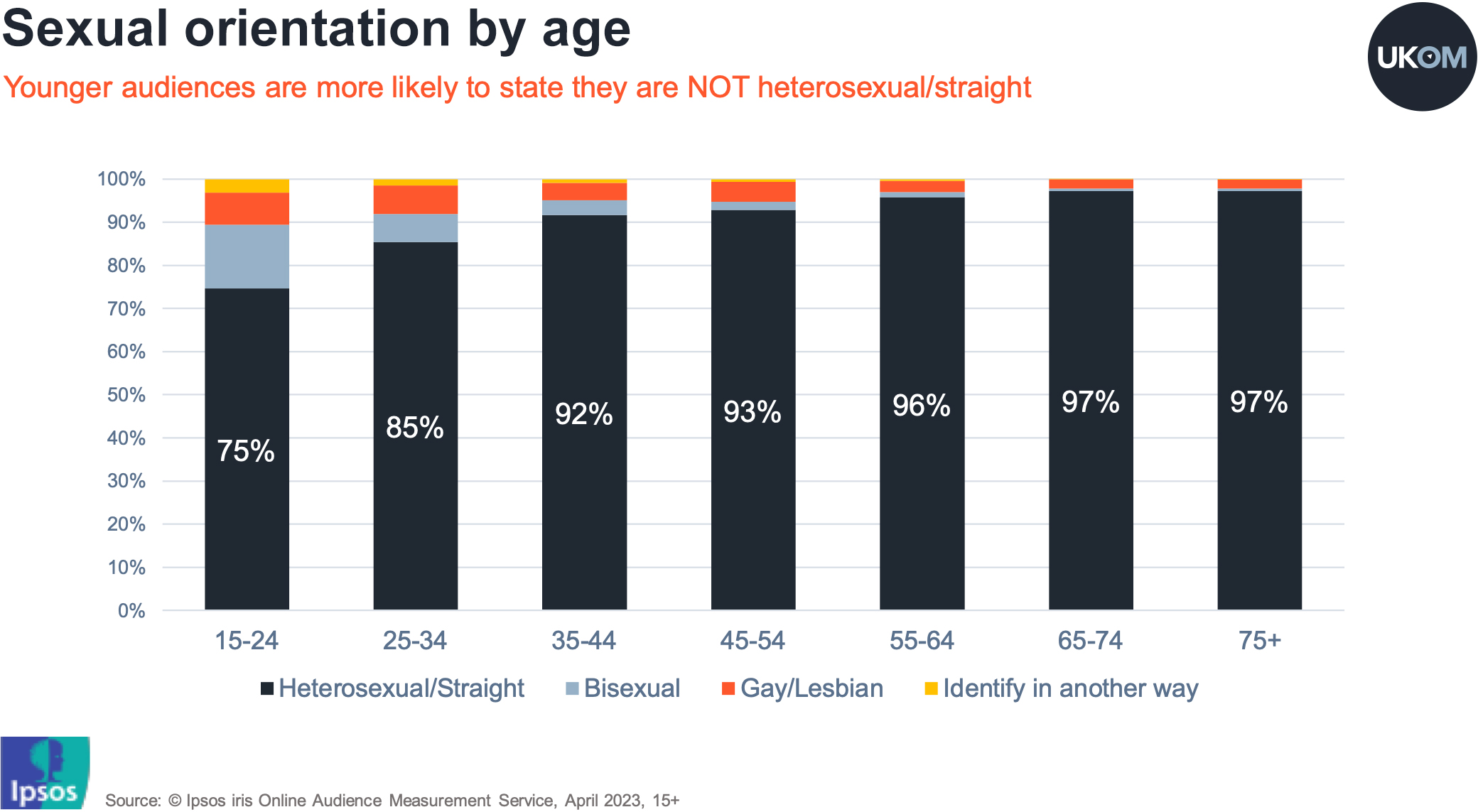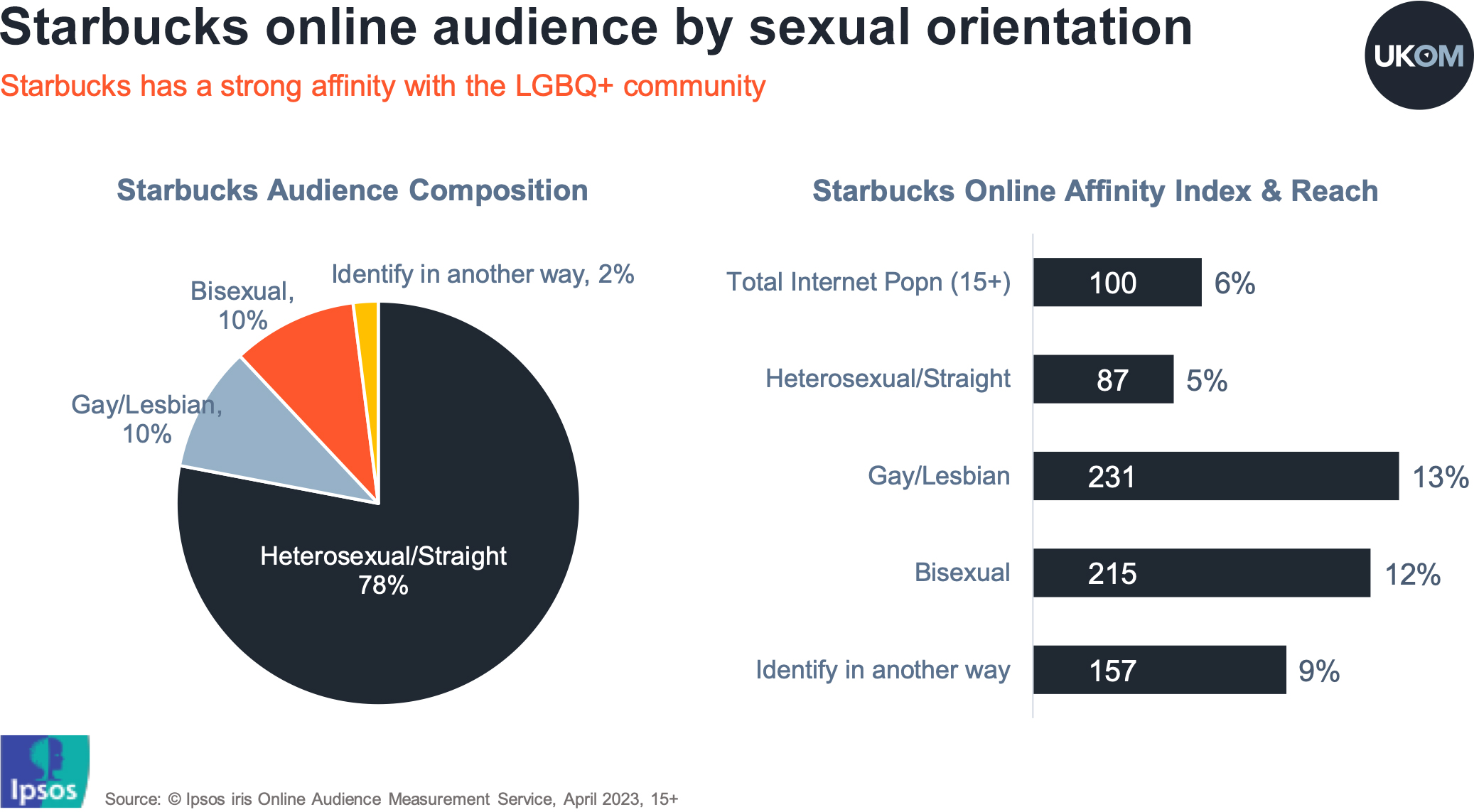Last week, Ipsos released new profiling targets within iris enabling advertisers and publishers to better understand internet usage among people by their sexual orientation.
This is particularly timely given June is Pride month. Ensuring media and brands are truly inclusive has never been easier given the information and insight now available about consumers. When Ipsos asked sexual orientation questions in April 2023, 90% of UK internet users identified as heterosexual/straight, 4.6% as bisexual, 4.5% gay/lesbian and 1% identified ‘in another way’. Questions on transgender were not asked by Ipsos so for the purposes of this analysis, the acronym LGBQ+ will be used to refer to the 10% identified in the survey who classify themselves as lesbian, gay, bisexual or in another way – that’s over 5 million people.
The data also suggests there is a correlation between age and sexual orientation (or willingness to reveal sexual orientation) as whilst 97% of those aged 75+ claimed to be straight/heterosexual this was significantly lower - only 75% - among those aged 15-24. Obviously different generations' attitudes to divulging personal information may have an influence here, but it’s important to point out as there is a clear relationship between age and usage of online services and apps which cannot be ignored.

In addition to better helping with targeting, the new profiling category can help brands which have been historically very supportive (or non-supportive) of the LGBQ+ community understand the impact of their actions. Starbucks has historically been a champion for LGBQ+ representation in advertising and a strong supporter of Pride and this is reflected in their online user profile. 2.7 million people or 6% of the UK online population visited the Starbucks app or website in April 2023 but reach was more than double this among both gay and bisexual audiences. Additionally, 22% of Starbuck’s audience identified as LGBQ+, compared to only 10% for the online UK population.

As advertisers embrace diversity and inclusive marketing, Ipsos iris can provide valuable website and app usage data over time. In the wake of backlashes for some brands (e.g. Budweiser) such tracking data can be useful in understanding the impact that new initiatives have on audiences. Market data can also provide useful insights into how brands are performing compared to the competition among their target audience e.g. Adidas v Nike, who both have Pride collections.
In addition to brands and advertisers, publishers are also able to look at their user profile by sexual orientation and as one may expect, there are differences between newspaper brands. The Evening Standard (index – 111), and the Guardian (index – 110), perform better amongst those who classify themselves as LGBQ+ compared to the Mail Online (index – 93), The Daily Star (index – 88) and the Daily Express (index – 75). However, quite often when broken down further, the data illustrates that reach and indexes for national newspapers are lower among those who are bisexual compared to those who are gay/lesbian so even though it’s often considered together, LGBQ+ is not one homogenous group. As previously pointed out, age may also play a role here too as the Daily Express has a much older profile than the Evening Standard.
This month, Glamour Magazine is celebrating Pride by featuring Logan Brown, a pregnant transgender man, on the cover of its June Pride digital issue. When looking at usage of Glamour online by sexual orientation, there is a strong affinity with LGBQ+ audiences with high affinity indexes among those who identify as gay/lesbian (index – 138), bisexual (index – 208) and ‘in another way’ (index – 208). It will be interesting to track usage and affinity for Glamour magazine by sexual orientation when the Ipsos iris June data is released.
Sexual orientation is just one of the new profiling capabilities within Ipsos iris but it’s not the only one that can help ensure marketing and media is truly inclusive. Online behaviour can now be analysed by audiences with various disabilities including mental health conditions, learning difficulties, vision and hearing impairment and other physical and health problems. For more information on Ipsos iris and the new targets please click here.
If you would like to know more about UKOM please click here or follow us on twitter at @UKOMAPS.
Notes on data:
Source: UKOM Ipsos iris Online Audience Measurement Service, April 2023.
Base = all aged 15+ years using PC/laptop, smartphone or tablet device(s).
- Audience Reach (%) The percentage of people in a target audience who visited the selected media in April 2023.
- Audience Composition (%) = The percentage of the target audience from the total audience of the selected media in April 2023. Formula: (Target Audience/Total Audience - All Internet) x 100
- Audience affinity Index = The ratio of audience composition to the target audience composition from the selected universe. Formula: (Audience Composition/Audience composition – Total Internet) x 10
The following new question was added to the study in April 2023 among all internet users aged 16+ to gather data on sexual orientation.
Which of the following describes your sexual orientation?
- Heterosexual/Straight
- Gay/Lesbian
- Bisexual
- Identify in another way









